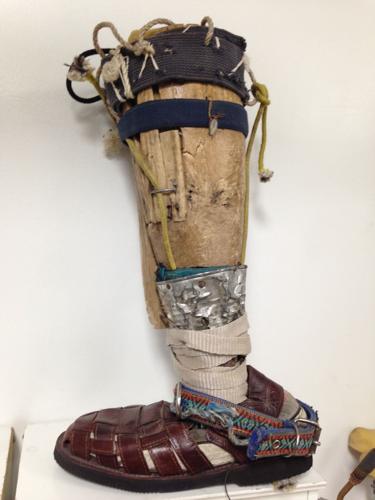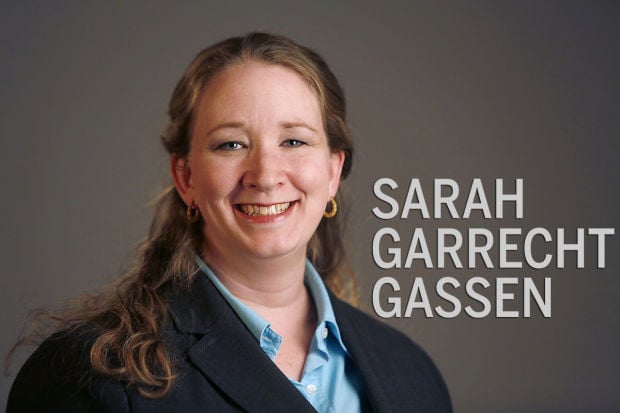NOGALES, SONORA
This leg has a story.
It’s a story of extreme need, yes, but also a demonstration of human ingenuity.
The leg is carved from a tree branch, hollowed out at the top where the man who made it inserted his amputated leg. A few pieces of upholstery foam cushion against the hard wood.
Press your fist down on a table and lean your body weight onto it, and you’ll get an idea of what walking on that would feel like.
A tin can is hammered and nailed below. A Converse low-top tennis shoe is the foot, bound to the metal with ropes, belts and what looks to be a dog collar. A left-footed sandal is jammed on top of the tennis shoe.
Its wearer, a man in his mid-80s from Puerto Peñasco, built this wooden leg because he needed to get around.
That get-it-done ethos drives ArSoBo, the cross-border nonprofit organization that helped this gentleman trade in that leg for a new limb built by a certified prosthetist, with a plastic padded socket fitted specifically to him and a rubber foot designed to help him walk.
The wooden leg now stands above a workbench at the ArSoBo clinic in Nogales, Sonora. ArSoBo, short for Arizona Sonora Border Projects for Inclusion, helps people in Mexico get the prosthetics, hearing aids and all-terrain wheelchairs they need. They employ people with disabilities to make the devices.
Access to such life-changing equipment is scarce for many in Mexico because of cost or scarcity of providers, said Francisco “Kiko” Trujillo, the director of ArSoBo in Mexico. Since 2010, the nonprofit has provided 279 wheelchairs, about 300 prosthetic limbs and 350 hearing aids. Hundreds of people, from babies to elders, are on the waiting list. Recipients are asked to pay what they can, and about half can’t afford anything.
The project grew out of the first Border Conference on Disabilities held in Nogales, Sonora, in 2008. Since then it’s grown to be a full-fledged operation with several staff members and many volunteers from both sides of the border. It’s funded by donations and grants from the University of Arizona, civic groups like Rotary International and businesses.
Dr. Burris “Duke” Duncan, a UA professor of public health who helped found the organization, said, “The need is there and people come up to it, and it’s just incredible.”
I joined the group from Arizona last Saturday at the Nogales facility for the prosthetics and hearing clinics. People began showing up at 6 a.m. They waited for hours as volunteer medical practitioners from Arizona called them back one-by-one. A nearby church provided dozens of homemade cheese sandwiches, nopal salad and bottled water.
It was organized chaos. People worked quickly, so they could attend to as many clients as possible. Audiologists did hearing tests and took molds for hearing aids (which will have solar battery chargers).
In the prosthetics room, technicians built legs from piles of donated mechanical knees and feet, pairing them with the white plastic sockets that had been custom built in Arizona by Hanger, an orthotic and prosthetics company, according to each recipient’s measurements.
With the translating help of UA student Eliza-Guadalupe Molina Del Rio, I spoke with Marcos Ibarra Valenzuela and Andrea Sumaya. They were waiting while the prosthetists, led by Eddie Escobar from Hanger’s Speedway office in Tucson, assembled their new limbs.
I know Eddie’s work, since he’s my prosthetist, too. He works deftly, quickly and intuitively.
Marcos and Andrea had traveled seven hours with their daughter and granddaughter from San Luis to Nogales. This trip had a mission — enter the ArSoBo clinic on wheels, but leave on two feet.
Eddie sat with Marcos, trying to get his organic leg into the socket. It didn’t fit. The shape of his amputated leg had changed in the months since he’d been measured. Andrea’s new leg was a success, and she was able to walk, slowly and while gripping a walker. She has a long way to go, but she’s upright.
The family decided the journey was too difficult, and too expensive, to make again. Eddie showed Marcos how to wrap his organic leg in an ace bandage to help it shrink in size, and how to make sure the prosthesis is at the right height.
It’s not the outcome Marcos or Eddie wanted, but it’s the best they could do.
Wearing that carved wooden leg was the best one man could do, for many years.
But an organization like ArSoBo shows that people, working with ingenuity together across borders, can take the best an individual can do and make it better.





